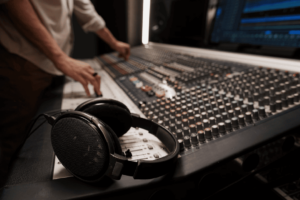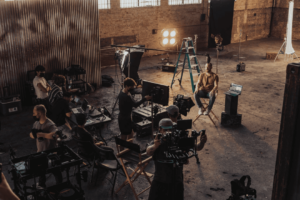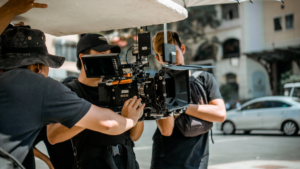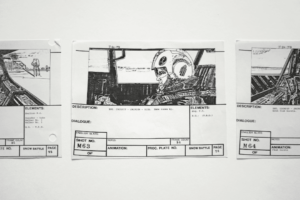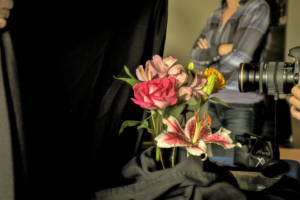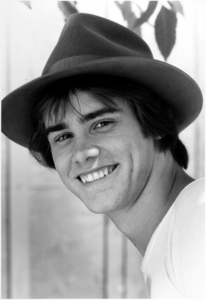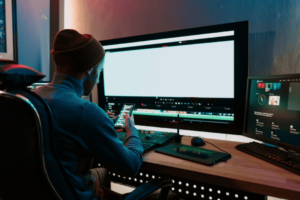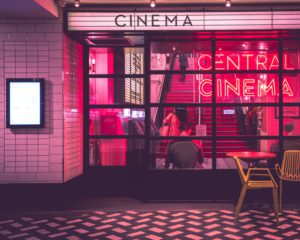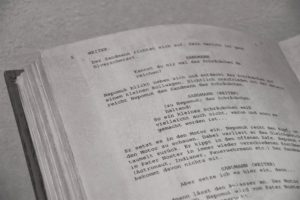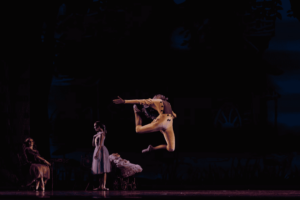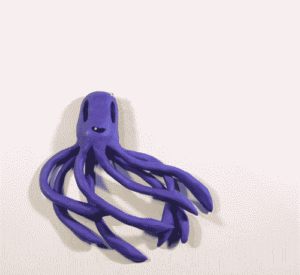A dolly shot is a camera movement technique that cinematographers use to follow a subject in action. It is also known as a tracking shot or trucking shot. The camera is mounted over an apparatus called the “dolly” to facilitate tracking. It is moved in front of, behind, or alongside a subject, such as an actor, location setting, product, etc. Therefore, it helps create smooth and controlled footage of the subject’s movement.

Cinematography is nothing but visual storytelling. You can imbibe your audience into the scene through the proper camera movement. Hence, choosing the most suitable camera movements helps you craft a compelling story to reach your audiences. One of the most popular camera movement techniques to adopt is the dolly shot. Here in this article, we walk you through the various facts about a dolly shot – technique, use, creation, and types. Read on to learn more.
Purpose of a Dolly shot
You can apply dolly shots to various situations to dramatically impact the viewer. When used along with other camera movements, dolly shots highlight the theme or message of the scene and are used in the following ways:
1. Draw the Viewer’s Attention
A slow dolly movement attracts your viewer’s attention to a specific action. It creates a zooming-in effect for a viewer and quickly grasps their attention. Additionally, a slow dolly movement diminishes the distance between a character and their audience. As a result, it establishes an emotional bonding and instills intimacy.
2. Reveals a Location
When you want to establish a location, you could move forward or backward to reveal its details. A forward dolly shot usually builds upon a viewer’s anticipation, while a backward dolly shot shocks the viewers with information that was previously not shown to them.
3. Create Depth
Dolly shots can visually transmit the viewer to a scene as they move through it. As a result, they reveal the details of a scene’s location, which helps the audience understand the actual event.
4. Character Realization
Dolly shots are usually used when a character suddenly jolts and realizes the surroundings or when a character sinks into a thought process to learn something. These behavioral traits of the characters attract the audience’s attention. Additionally, they stir up emotions and quickly create a tense environment.
5. Create Isolation
You can create an isolating effect by focusing on everything that moves away from your character. This way, you can amplify the loneliness of your character. For this purpose, you can dolly in and zoom out your camera. The forward movement of your dolly extends the background behind your subject. Also, it maintains your subject’s size on the screen.
6. Introduce Obstacles
Dolly shots are a great way to introduce obstacles to your character. It stretches the natural world and twists them to project a dangerous situation around a character.
7. Produce Psychological effects
Additionally, dolly shots are beneficial tools to generate a dizzy or surreal atmosphere. Hence, they can effectively depict drug use, paranoia, or mental illness in a film.
How is a Dolly Shot Created?
You can shoot a dolly shot in two different ways with the help of a dolly grip. A dolly grip refers to a devoted technician explicitly trained to operate the camera dolly.
Camera dolly
A camera dolly is a platform with wheels over which a camera is mounted to transport it along a set of rail tracks. Therefore, a camera operator is required to move the dolly. However, a camera assistant and a dolly grip also control the dolly. Additionally, while shooting with camera dollies, you need to film the scene by placing the camera perpendicular to the rail tracks. This way you can avoid the rail tracks from being visible. Alternatively, you can also use post-production to remove rail tracks.


Dolly Cart
“A dolly cart is devoid of a rail track; hence it requires a smooth surface to move along with a set of wheels. A camera is then mounted over the cart to facilitate camera movement. As a result, Dolly carts provide a greater degree of movement. On the contrary, driving over an uneven surface will compromise a shot’s steadiness.”

Different Types of Dolly Shots
1. Dolly In and Dolly Out
When you move the camera smoothly toward the subject, it is labeled “dolly in.” On the contrary, you dolly out when you move your camera away from the subject. Additionally, some dollies come with a provision for the vertical movement known as the pedestal move. However, a dolly can be mounted over a crane for additional height and flexibility. During this standard dolly movement, the need for a secondary camera movement is minimal. However, you may have to manually adjust the focus distance to maintain the focus on your subject. This shot helps build anticipation and suspense in your viewer’s minds.
Indiana Jones and the Raiders of the Lost Ark – The Golden Idol
The camera focuses on Indiana in the above scene while advancing toward the golden idol. It dollies out when he moves away from the idol.
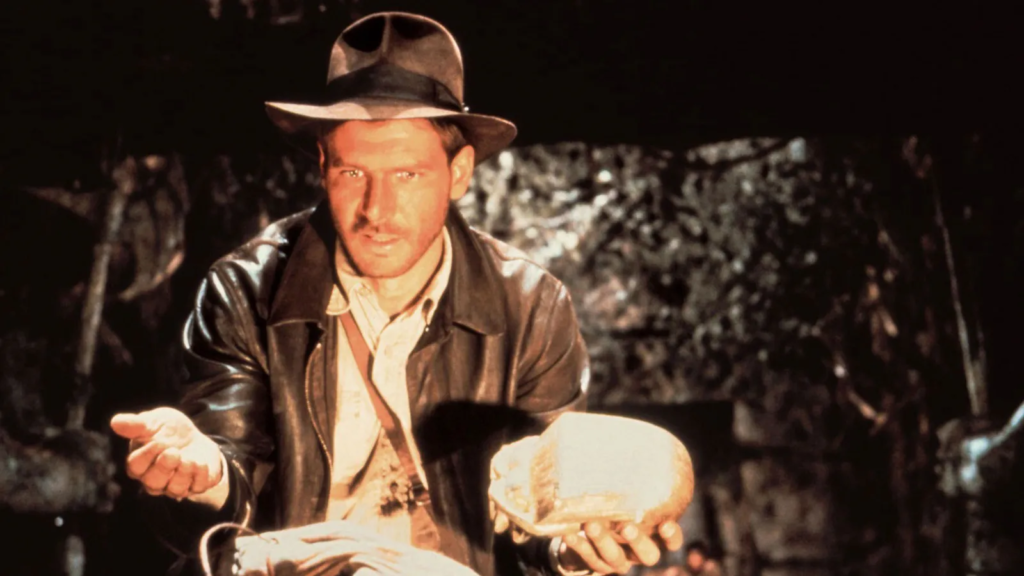
2. Dolly Zoom
Dolly Zoom is the most popular and tricky shot that involves a back-and-forth camera movement while also zooming the lens. You can use this shot to amplify the background. Eventually, this shot successfully leaves a visual and psychological effect on your viewer when it outgrows the foreground. Hence, it is an indispensable tool in creating a hallucinatory or frightful experience for the viewer.
Jaws(1975) – Get out of the water scene
For example, the clip from the movie Jaw uses a dolly zoom shot to highlight the sense of panic and horror on Brody’s face. The dolly zoom shot elevates the actor’s performance and differentiates the legendary movie.
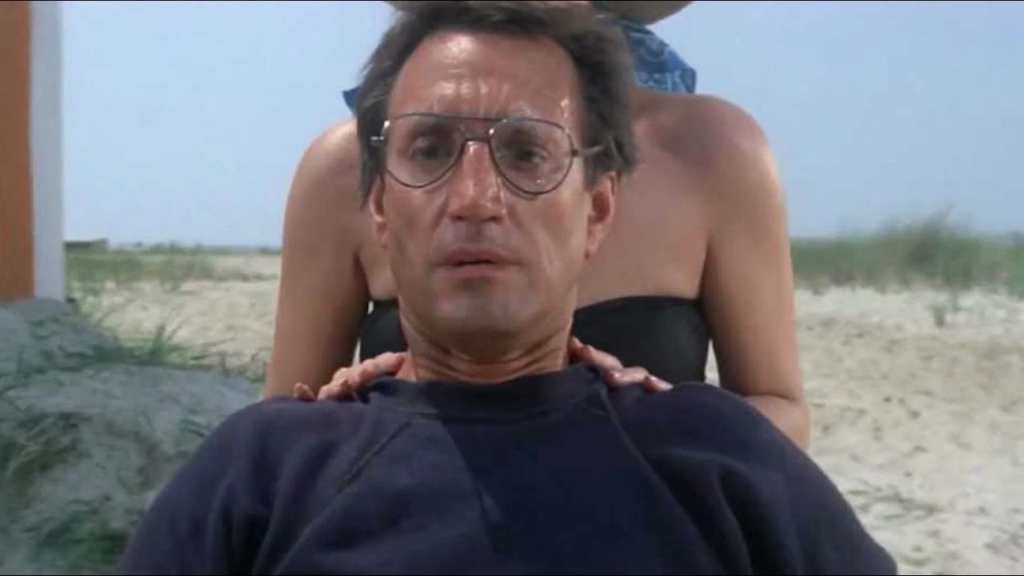
Here’s another scene from The Lord of the Rings that highlights the Dolly zoom shot:
The Lord of the Rings – A Short Cut to Mushrooms (HD)
3. Dolly with Secondary Camera Movements
When your subject is moving, or you want to draw your viewer’s attention to something specific, you can add some secondary camera movement along with your dolly shot. For this purpose, you could use the techniques of panning, tilting, or rolling the camera.
Cinematography Tutorial: Camera Slider movements
4. Dolly Tracking Shots
These shots showcase an actor’s movement from one place to another. As a result, these shots slide alongside the actors as they move. Hence, it also reveals the scope of the world as seen by the character. It is a compound shot when a tracking shot is combined with vertical dolly movement.
For example, in the film Full Metal Jacket, Sergeant Hartman’s movement is tracked with the help of a dolly shot. In this scene, the tracking shot is used to reveal the commanding status of the Sergeant.
Full Metal Jacket- Jelly Doughnut Scene
However, Joe Wright’s Hanna uses tracking shots to track Eric. These shots reveal the scope of the location that Eric crosses and signify his mission. Further, it also uncovers that he is being followed.
5. Long Tracking Shots
Often referred to as “one takes,” long tracking shots follow a character for a prolonged period. A camera dolly with a significant rail length is essential in this shot as its map can be winding and complicated.
The below example from the movie Spectre is a perfect example of a long shot.
6. 360 Dolly Shot
A 360 dolly shot follows a circular motion around a character. Hence, it provides a good glimpse into the scope of a scene. In particular, this type of shot works well for an action scene as it shows the fighter’s courage in the scene. For example, in the movie The Book of Eli, Eli fends off many people who fight against him.
The Book of Eli- Bar Fight scene
Additionally, you can use the 360 dollies shot to add interest to a scene. For example, Scorsese’s The Wolf of Wall Street employs a 360 dolly shot to convert a dull scene into an exciting piece of a visual treat.
The Wolf of Wall Street- The key to making money scene
7. Spike Lee or the Double Dolly Shot
The Spike Lee shot is quite different from other dolly shots as it throws light into a character’s state of mind. This creates an opportunity for the viewer to travel along with the character throughout the movie’s journey. Hence, it perfectly defines the emotions that stir through a film. Therefore, this shot puts the actor and the camera on the dolly, giving a floating-like appearance. Here is a montage of the spike lee dolly shot.
Videos
Difference between a dolly shot and a zoom shot
Dolly Shot in 20th-Century Women
Dolly shot that went unnoticed in Interstellar
Tarantino’s Death Proof- Dolly Shot
How to Plan and Shoot a Dolly Shot?
A dolly shot enhances your story and is relatively straightforward to use. However, some primary considerations to look out for when shooting a dolly shot and getting the most out of it.
Step 1: Storyboarding and Shot Listing
Once you have distilled the scene from the sequence of events for a perfect dolly shot, you need to add it to a shot list. A shot list helps the rest of your crew members prepare well in advance for the shot. Since these shots involve a lot of planning, they have to be shot-listed to combine scenes and creatively make the movie a grand success.
Step 2: Budgeting
The decision to use a dolly camera movement is dependent on a movie’s budget. The cost of renting a dolly, its track, setup, and striking a camera dolly rig, and its required period are the factors that decide the availability of dolly equipment. Therefore, ensuring these will help you confirm that you can include these shots in your movie.
Step 3: Equipment
You need to ensure you have the necessary dolly equipment ready before starting your shoot. However, there are certain factors to consider while planning for the equipment, they include:
- Dolly tracks facilitate the movement of dollies. Tracks that are straight and curved are pretty easy to construct, while certain other tracks may be time-consuming.
- Specific camera movements: You must plan this movement priorly, as they may require a crane on the dolly.
Depending on the scale of your project and budget, you can choose from a range of professional dolly equipment for your shoot. Some of the frequently used tools for dolly shots include the following:
Industry Dolly Equipment
1. Cinema Platform Dolly is one of the most frequently used dolly equipment. It can often be seen in behind-the-scenes blockbuster movies. To avail of this equipment, you need to contact a professional equipment rental house. One of the latest dolly equipment from Chapman/Leonard’s is Hybrid IV. It has many features and accessories and is the best choice for cinematographers.

2. Doorway Dolly is the primary or economical version of a cinema platform dolly. It consists of a flat, stable platform that runs with the help of wheels. Its price varies depending on the features. However, there are affordable options for smaller-sized studios. The Matthews Doorway Dolly is a popular option among the doorway dollies available.

3. Slider: A slider is a miniature version of the cinema platform dolly, devoid of a dolly. With this setup, you can directly mount your camera onto the rails. Hence, it is ideal for smaller dolly movements. There are various sliders available in the market today.

4. Tripod Dolly: Tripod dollies are wheels that you can connect to your existing tripod. Hence, it facilitates movement and is quite affordable. However, these dollies can work well over smooth studio floors and are unsuitable for uneven surfaces. The tripod dolly set from Magnus is an excellent example of this dolly type.

5. Steadicam: A Steadicam is different from a dolly as it acts as a camera stabilizer. However, it offers a tracking camera movement like a dolly. It consists of counterweights, springs, and balances that mechanically isolate an operator’s movement. This calls for the operator to be well-trained to handle it appropriately. Steadicams have been prevalent in the film industry for decades and thrive today.

6. 3-Axis Gimbal: You can use a 3-axis gimbal for a tracking shot, but it is not dolly equipment. It operates similarly to a Steadicam; however, it balances with the help of electric motors. Thus, it is easy for operators who don’t have prior experience working with Steadicams.

Other Unique Film Equipment
Some of the other industry dolly options to consider include:
- Cable Camera Systems: They offer a lot of distinct rigs.
- A Professional Drone: A drone enhances your ability to create omnidirectional smooth dolly shots. It eliminates the need for track rails and other equipment. Additionally, it is the best option when shooting remotely or establishing a shot.
- Table-Top Dolly: This setup facilitates smooth table-top movement with the help of wheels. These wheels are usually mounted over a smaller camera body.
Non-Traditional Dolly equipment- Capturing Dolly Shots on Budget
If you are limited in your budget or exploring various creative options, you can use the below-mentioned non-traditional methods to create a dolly shot.
Wheelchair
A wheelchair can be an effective tool for shooting a dolly shot as it comes with the following features:
- It offers stability to the camera as it has provisions for the camera operator to sit.
- Its smooth and stable wheels facilitate turning.
- Its handles at the back accommodate a secondary operator who could steer.
Vehicle
A vehicle qualifies for dolly equipment as it has wheels that promote movement. Additionally, the presence of shocks and air tires makes its move smooth. However, if you encounter bumps while shooting, you may have to consider correcting them during the post-stabilization phase.
Roller Skaters
If you want an inexpensive option, you can avail the help of roller skaters. However, although roller skaters can help you capture remarkable smooth footage, you need first to practice wearing them before you explore with them.
One wheel
Of late, the usage of one wheel is gaining prominence among cinematographers. They are preferred for their hands-free operation and smooth movement due to the presence of an aired tire. Additionally, they are used on trails off-road and behind-the-scenes.
Small Drone
Small drones offer greater portability as dolly equipment. Moreover, they help create footage free from the disturbances of the wind due to their smaller size. Additionally, you can also use them indoors with slow-moving modes.
Step 4: Location Scouting and Set Design
You need to consider your location before your shoot. See if you will have enough space to accommodate the tracks to get your shots in an existing setting. First, however, you need to check if it is leveled for an exterior location. If unlevelled or rocky, you will have to balance it to lay tracks and get the smoothest shot.
Step 5: Scheduling
Time is a crucial element when adding a dolly shot to your shot list. Since a dolly shoot requires a smooth surface, it will consume most of your time leveling the ground. As a result, you need to schedule your dolly shot once your scene is ready for it. Additionally, ensure to call your crew in advance whenever a set requires additional setup or equipment.
Step 6: Shooting
Once you plan and schedule your shoot, you must be prepared to shoot. In film production, dolly shots add value to the film, as they retain a high level of precision. However, it can also be time-consuming and requires a lot of planning.
Conclusion
You can use dolly shots widely across your film. As these shots connect your character with the audience, ensure to include them with a purpose. Additionally, satisfy your goal of conveying a particular emotion to your audience. This way, you can fill your film with excellent dolly shots that keep your audiences engaged throughout the journey of your movie.
